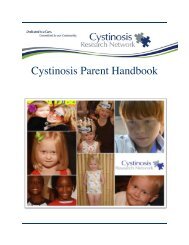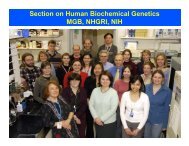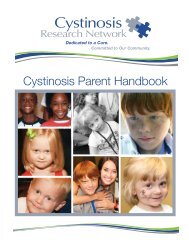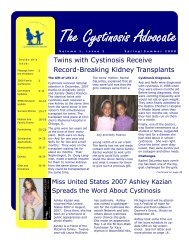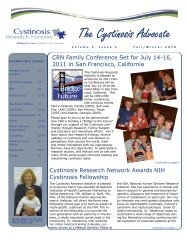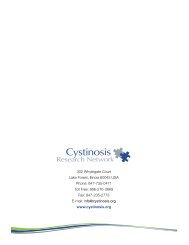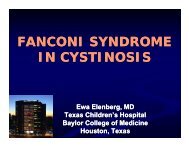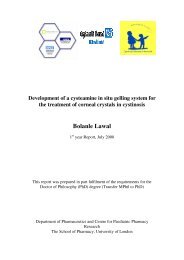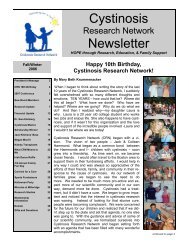Evaluation of Novel Prodrugs for the Treatment of Nephropathic ...
Evaluation of Novel Prodrugs for the Treatment of Nephropathic ...
Evaluation of Novel Prodrugs for the Treatment of Nephropathic ...
Create successful ePaper yourself
Turn your PDF publications into a flip-book with our unique Google optimized e-Paper software.
Interim report July 2008<br />
<strong>Evaluation</strong> <strong>of</strong> <strong>Novel</strong> <strong>Prodrugs</strong> <strong>for</strong> <strong>the</strong> <strong>Treatment</strong> <strong>of</strong><br />
<strong>Nephropathic</strong> Cystinosis<br />
Dr Rachel Knott, Dr Graeme Kay and Pr<strong>of</strong>essor Donald Cairns<br />
The School <strong>of</strong> Pharmacy and Life Sciences,<br />
The Robert Gordon University,<br />
Schoolhill,<br />
Aberdeen<br />
UK<br />
AB10 1FR<br />
Summary<br />
Background: The design and syn<strong>the</strong>sis <strong>of</strong> novel prodrugs which are an odourless, and<br />
tasteless oral <strong>the</strong>rapy <strong>for</strong> <strong>the</strong> treatment <strong>of</strong> cystinosis has been carried out and we are<br />
now evaluating <strong>the</strong>ir efficacy. As a result <strong>of</strong> <strong>the</strong> support received from CRN we have<br />
appointed a post-doctoral research fellow to evaluate <strong>the</strong> efficacy <strong>of</strong> novel pro-drugs<br />
and have now demonstrated that at least one <strong>of</strong> <strong>the</strong>se prodrugs, cysteamine<br />
decanoate, is able to deplete levels <strong>of</strong> intracellular cystine. These results were<br />
recently published (McCaughan et al., 2008). We are now determining <strong>the</strong> time<br />
course at which <strong>the</strong> prodrug is able to deplete <strong>the</strong> cystine in comparison to<br />
cysteamine and evaluating <strong>the</strong> efficacy <strong>of</strong> o<strong>the</strong>r candidate compounds.<br />
Results: In <strong>the</strong> first 6 months <strong>of</strong> this project we have consolidated our initial<br />
observations by investigating shorter time periods <strong>of</strong> exposure <strong>of</strong> cystinotic cells to<br />
<strong>the</strong> novel prodrug (48 hours). These results have indicated that cystamine decanoate<br />
is able to reduce <strong>the</strong> level <strong>of</strong> intracellular cystine and <strong>the</strong> results <strong>of</strong> this are<br />
summarised in <strong>the</strong> text below.<br />
Conclusions : These data support our hypo<strong>the</strong>sis that <strong>the</strong> novel prodrug is able to<br />
reduce intra-lysosomal cystine while at <strong>the</strong> same time <strong>of</strong>fering <strong>the</strong> prospect <strong>of</strong> an<br />
odourless and tasteless oral <strong>the</strong>rapy. While <strong>the</strong> pro<strong>of</strong> <strong>of</strong> concept is now<br />
demonstrated we now wish to identify <strong>the</strong> effect <strong>of</strong> <strong>the</strong> novel prodrug after shorter<br />
periods <strong>of</strong> time (24 hours and compare its efficacy to that <strong>of</strong> cysteamine, <strong>the</strong><br />
current oral <strong>the</strong>rapy.<br />
Fur<strong>the</strong>r work: During <strong>the</strong> remaining 6 months <strong>of</strong> funding we wish to evaluate more <strong>of</strong><br />
<strong>the</strong> novel prodrugs in our cystinotic cell model. In order to continue this work we<br />
have submitted a grant to CRN <strong>for</strong> consideration to fund this work <strong>for</strong> an<br />
additional24 months funding. This would enable us to characterise <strong>the</strong> apoptotic<br />
status <strong>of</strong> <strong>the</strong> cells following addition <strong>of</strong> <strong>the</strong> prodrug and enable us to develop a<br />
human cell CTNS knockout which would greatly facilitate <strong>the</strong> screening <strong>of</strong> fur<strong>the</strong>r<br />
prodrugs.<br />
Knott, Kay and Cairns
Interim report July 2008<br />
INTRODUCTION<br />
Cystinosis is caused by a mutation in <strong>the</strong> gene encoding cystinosin which is a<br />
lysosomal membrane transporter 1 . Defects in this transporter protein result in a<br />
build up <strong>of</strong> cystine in <strong>the</strong> lysosomes causing progressive cell damage, apoptosis and<br />
cell death 2 . Current <strong>the</strong>rapy involves regular administration <strong>of</strong> cysteamine which is<br />
an aminothiol with a characteristically <strong>of</strong>fensive taste and smell resulting in halitosis,<br />
body odour and gastric irritation 3 . Patient compliance is poor and this is attributable<br />
to <strong>the</strong> adverse side-effects and <strong>the</strong> regularity <strong>of</strong> administration. We have syn<strong>the</strong>sised<br />
a library <strong>of</strong> prodrugs with <strong>the</strong> aim <strong>of</strong> improving <strong>the</strong> pharmacodynamic properties <strong>of</strong><br />
cysteamine with a corresponding increase in patient compliance. We report here on<br />
<strong>the</strong> results <strong>of</strong> one <strong>of</strong> <strong>the</strong>se prodrugs, cystamine decanoate with respect to <strong>the</strong><br />
reduction <strong>of</strong> cystine in <strong>the</strong> lysosomes.<br />
METHOD<br />
Cell culture: Cystinotic fibroblasts were purchased from Coriel Laboratories<br />
(GM00008) and cultured using MEM supplemented with 15% FCS, 2mM L-<br />
glutamine, 1U/ml penicillin and 1g/ml streptomycin. Human umbilical vein<br />
endo<strong>the</strong>lial cells (HUVEC) were purchased from The European Collection <strong>of</strong> Cell<br />
Cultures (ECACC) and cultured using GMEM supplemented with 10% FCS, 2mM L-<br />
glutamine, 1U/ml penicillin and 1g/ml streptomycin . The cells were grown at 37ºC<br />
in a humidified atmosphere <strong>of</strong> 5% CO2 /95% room air and were expanded when<br />
<strong>the</strong>y reached approximately 80% confluence.<br />
Detection <strong>of</strong> cystinosin: Cystinotic fibroblasts and HUVEC were seeded into<br />
chamber slides and grown to confluence. The respective growth medium was<br />
removed and <strong>the</strong> monolayers were washed three times in phosphate buffered saline,<br />
left to air dry, fixed in 4% para<strong>for</strong>maldehyde and stored at -20 o C until required <strong>for</strong><br />
immunocytochemistry. The primary antibody raised against a syn<strong>the</strong>tic peptide <strong>of</strong><br />
cystinosin (Lifespan Biosciences) was added to <strong>the</strong> cells followed by a biotinylated<br />
anti-rabbit antibody (Molecular probes). Specific binding to cystinosin was<br />
visualised with <strong>the</strong> addition <strong>of</strong> streptavadin alkaline phosphatase and application <strong>of</strong><br />
<strong>the</strong> appropriate substrate. Positive staining was evident as a red colour.<br />
Labelling <strong>of</strong> apoptotic cells: Cystinotic fibroblasts and HUVEC were seeded in<br />
chamber slides at a density <strong>of</strong> 0.25 x 105 cells/ml. On reaching 80% confluence, <strong>the</strong><br />
media was removed and replaced with fresh media containing YO-PRO (1 in 10,000<br />
dilution). The chamber slides were <strong>the</strong>n returned to <strong>the</strong> incubator <strong>for</strong> 30 minutes,<br />
be<strong>for</strong>e removing <strong>the</strong> media and rinsing three times in ice cold phosphate buffered<br />
saline.<br />
Cystine determination: Cystinotic fibroblasts were seeded into 75cm2 flasks (Nunc)<br />
and were used between passage 12 and 20 when <strong>the</strong>y were a minimum <strong>of</strong> 80%<br />
confluent. At this point ei<strong>the</strong>r <strong>the</strong> novel prodrug (50M), cysteamine (50M) or<br />
vehicle control (1% ethanol) were added to <strong>the</strong> flask. After 48 hours incubation <strong>the</strong><br />
cells were harvested and <strong>the</strong> level <strong>of</strong> lysosomal cystine was determined using a novel<br />
reverse-phase HPLC as previously described 4 .<br />
Knott, Kay and Cairns
Interim report July 2008<br />
RESULTS<br />
The cystinosin protein was visualised as a red colour in HUVEC (Fig. 1a) localised<br />
predominately in <strong>the</strong> perinuclear region with some staining dispersed throughout<br />
<strong>the</strong> cytoplasm. Staining was also evident in cystinotic fibroblasts (Fig. 1b) although<br />
<strong>the</strong> distribution <strong>of</strong> <strong>the</strong> protein was markedly different with diffuse staining<br />
throughout <strong>the</strong> cytoplasm.<br />
a<br />
b<br />
Figure 1: Immunocytochemical detection <strong>of</strong> cystinosin in HUVEC (a) and cystinotic<br />
fibroblasts (b)<br />
Apoptotic cells were visualised as a green fluorescent stain reflecting <strong>the</strong> enhanced<br />
membrane permeability associated with apoptosis. HUVEC showed no evidence <strong>of</strong><br />
apoptosis (Fig. 2a) while <strong>the</strong> majority <strong>of</strong> cystinotic fibroblasts showed intense nuclear<br />
stain.<br />
a<br />
b<br />
Figure 2: Detection <strong>of</strong> apoptotic HUVEC (a) and cystinotic fibroblasts (b) using YOPRO<br />
The level <strong>of</strong> cystine in <strong>the</strong> lysosomes <strong>of</strong> cystinotic fibroblasts was determined<br />
following incubation with cysteamine or <strong>the</strong> novel prodrug cystamine decanoate and<br />
compared to a vehicle control. The level <strong>of</strong> significance <strong>of</strong> <strong>the</strong> findings was<br />
determined by <strong>the</strong> Student’s t test (n=7). Cysteamine (p
Interim report July 2008<br />
CONCLUSION AND FUTURE WORK<br />
This work has demonstrated that <strong>the</strong> novel prodrug cystamine decanoate is able to<br />
deplete lysosomal cystine in cystinotic fibroblasts after 48 hours with a comparable<br />
efficacy to <strong>the</strong> <strong>the</strong>rapeutic standard. Work is continuing to fur<strong>the</strong>r characterise <strong>the</strong><br />
efficacy <strong>of</strong> this compound and o<strong>the</strong>rs from a library <strong>of</strong> novel prodrugs and to<br />
determine <strong>the</strong> effect <strong>of</strong> <strong>the</strong> prodrugs on <strong>the</strong> stage and incidence <strong>of</strong> apoptosis in<br />
cultures <strong>of</strong> cystinotic fibroblasts.<br />
REFERENCES<br />
1. Town et al.,. (1998) Nature Genetics. 18. 319-324.<br />
2. Park et al., (2006) J. Am. Soc. Nephrol.<br />
3. Cairns et al., (2002) Pharm. J. 269, 615.<br />
4. McCaughan et al., (2008) Bioorg. Med.Chem.Lett. 18. 1716-1719.<br />
Knott, Kay and Cairns



